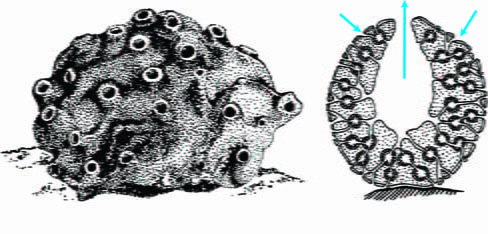Sponges are among the most fascinating marine organisms. Much of their functioning is well hidden within the sponge’s body. Thousands of tiny filter chambers are lined by collar cells, which feature a beating flagellum. The flagella beat and trap bacteria in the water, which is the main food for sponges. Here is a link showing the filter chambers in action.

Left: Picture of a typical sponge. Right: Idealized cross section, showing filter chambers and water flow.
Together, these collar cells beat and drive water through the many chambers. What is amazing is how they take advantage of a simple hydrodynamic principle. If you put your thumb across the opening of a water hose you will notice that the water velocity will immediately increase. Thus, if you reduce the cross-sectional area through which the water flows the velocity will increase. Even though the velocity generated by the flagellum of a collar cell is rather slow, the many thousands of chambers with collar cell together comprise a large cross-sectional area. The relatively small exit openings are a small proportion of the total cross-sectional area of the chambers, so the exit velocity of water is much greater, often 1-3 cm per second (about an inch per second). This exit velocity allows the sponge to get rid of its waste products.
West Meadow Creek has three common sponges. Most lovely are the sulfur sponges, that usually colonize and chemically bore into clam shells, but then spread over the bottom, especially on gravelly areas. One can see throughout the creek the large lovely yellow sponges, but they are especially abundant in summer on the gravelly and rocky bottom at the southernmost bend in the creek. Sulfur sponges cover the bottom, with several colonies over one-two feet in diameter.
Also common is the redbeard sponge. In most places, one sees very small colonies, but they form lovely and complex colonies in West Meadow Creek, especially in Sponge Grotto. Erect colonies six inches high and more are common here. Also to be found is the tan sponge, Halichondria.

The brown sponge Halichondria bowerbanki arrived from Europe in the late 19th century. This species is likely a group of species that have invaded our shores and continue to be transported from European waters.

Bottom dominated by Redbeard sponge Microciona prolifera. This is a view from a dock of sponges and their abundance in shallow water in West Meadow Creek.

Sulfur sponge bottom. Bottom dominated by Sulfur sponge Cliona celata. These colonies are up to 30 cm in diameter and are in very shallow water, easily seen by snorkeling.
Edited by J. Levinton May 2, 2024

